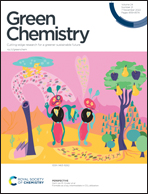Accessing suberin from cork via ultrafast supercritical hydrolysis†
Abstract
Natural biopolyesters in the form of suberin could be a promising resource for the synthesis of a wide array of chemicals, fuels and materials. However, access to this molecule is limited by a chemical-intensive and laborious work-up procedure based on alkaline hydrolysis or methanolysis. Herein, we propose the ultrafast supercritical hydrolysis as a novel and scalable approach for the facile access to suberin from cork. Supercritical water (SCW) with high or low ionic properties (pKw of 13 and 15) would allow the liquefaction of lignocellulosic materials while avoiding the hydrolysis of ester linkages. Therefore, extractives and carbohydrates partition in aqueous products while suberin and lignin are enriched in the solid products. Suberin yield reached as high as 66.6% of the dry cork at 386 °C and 1.27 s (pKw = 13), owing to the removal of up to 94.7% of polysaccharides content of the original cork biomass. The occurrence of repolymerization reaction, however, was observed under this condition, including an increase in Klason lignin presumably due to pseudo-lignin formation. Meanwhile, lower repolymerization products accompanied by a 77.1% polysaccharides and 14% lignin removal was achieved when working at 395 °C and 0.25 s (pKw = 15), at the expense of lower suberin yield of 59.8%. It appears that even a longer reaction time of 1.27 s would not lead to hydrolysis of ester linkages in suberin but influences the extent of liquefaction of the lignocellulosic matrix and the formation of repolymerization products. A lower ion product and a reaction time of less than 1 s would be preferable to strike a balance between maximum polysaccharides removal and minimum repolymerization products generation. This study has contributed towards the development of a new sustainable process to access valuable molecules from cork and has highlighted the importance of obtaining high quality and highly functionalized biopolymers as a source of new building blocks.



 Please wait while we load your content...
Please wait while we load your content...